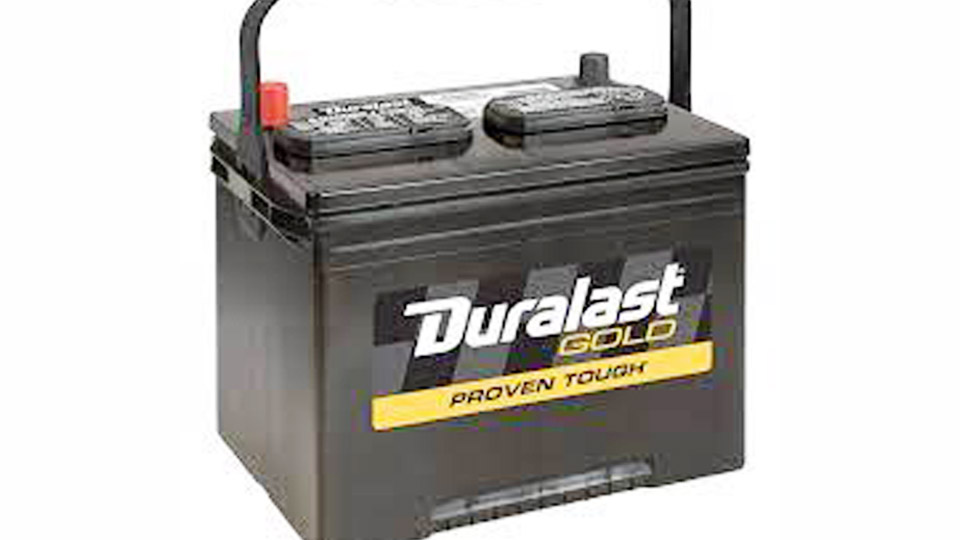How Old Is My Duralast Battery? Decode It in Seconds!
You’re turning the key in your car, and instead of that satisfying roar of the engine, you get a weak click or nothing at all. It’s frustrating, right? That’s exactly what happened to me with my 2005 Chevy Silverado a few years ago. I suspected the battery, a Duralast Gold I’d picked up from AutoZone, was the culprit.
But how old was it? Knowing the age of your Duralast battery can tell you if it’s time for a replacement, if it’s still under warranty, or if it’s causing your car’s electrical issues. Let’s dive into how to decode the date on your Duralast battery, what those codes mean, and why it’s worth checking.

Image by autozone
Why Knowing Your Battery’s Age Matters
Batteries don’t last forever. Most car batteries, including Duralast ones, have a lifespan of about 3 to 5 years. Some, like the Duralast Gold or Platinum, might stretch to 6 or 7 years if you’re lucky and take good care of them. I learned this when my truck’s battery started acting up after a cold winter. It was still cranking the engine, but barely, and I had a hunch it was getting old.
Knowing the age of your battery helps you plan ahead. If it’s pushing 4 years or more, it’s at higher risk of failing, especially in extreme heat or cold. Plus, Duralast batteries come with warranties—usually 2 years for standard models and 3 years for Gold or Platinum.
If your battery’s still under warranty, you might get a free replacement. I’ve been there, standing at the AutoZone counter, hoping my battery was young enough to swap for free. Checking the age also helps you figure out if the battery’s the real issue or if something else, like a bad alternator, is draining it.
Where to Find the Date Code on a Duralast Battery
The first step is finding the date code. Duralast batteries don’t make it super obvious, but once you know where to look, it’s no big deal. When I checked my Chevy’s battery, I found the code stamped on the top of the battery case, near the positive terminal. Sometimes it’s on the side or on a sticker near the terminals. It’s usually a small, engraved set of letters and numbers, or a round sticker with a code.
Look closely at the top or sides of the battery. You might need a flashlight if it’s tucked under a cover or in a tight spot. On my truck, the code was etched into the plastic, but I’ve seen Duralast batteries with a sticker that’s easier to read.
If the sticker’s worn off or the code’s hard to see, check your purchase receipt or AutoZone’s records if you bought it there. I once called my local AutoZone with the battery’s serial number, and they looked up the purchase date for me.
Decoding the Duralast Date Code
Now, here’s where it gets interesting. Duralast batteries use a letter-number code to show the manufacturing date. It’s not as simple as “Made on 3/15/2022,” but it’s not rocket science either. Here’s how it works, based on what I’ve seen on my own batteries and others I’ve checked:
Letter for the Month: The letter tells you the month. A is January, B is February, C is March, and so on up to L for December. They skip the letter I to avoid confusion with the number 1.
Number for the Year: The number is the last digit of the year. For example, 2 means 2022, 3 means 2023, and so on. If it’s an older battery, like from 2013, it’d be a 3 too, so you’ll need to use context (like the car’s age or your purchase date) to figure out the decade.
For example, if the code is “G2,” that means the battery was made in July 2022 (G is the seventh letter, 2 is 2022). My truck’s battery had a code of “C1,” which meant March 2021. Some batteries might have a longer code, like “C1XYZ123,” but you only need the first two characters for the date.
Occasionally, you’ll find a sticker with a clear date, like “03/22” for March 2022. That’s the easy case—just read it directly. But most Duralast batteries stick to the letter-number format. If the code looks different, like a week-and-year format (e.g., “35/21” for the 35th week of 2021), it’s rare but possible. I’ve only seen this on older models.
What to Do If You Can’t Find the Date Code
Sometimes, the date code is missing or too worn to read. This happened to me with a Duralast battery I pulled from a used car I bought. The sticker was gone, and the etched code was faded. Here’s what I did to figure it out:
Check Your Receipt: If you bought the battery from AutoZone, dig up your receipt. It’ll show the purchase date, which is usually close to the manufacturing date.
Call AutoZone: If you don’t have the receipt, call your local AutoZone with the battery’s serial number (usually on the top or side). They can often look up the purchase date if you bought it from them.
Look for Clues: Check for service stickers, installation notes, or records from your mechanic. I found an old oil change sticker in my truck that helped me estimate when the battery was installed.
Inspect the Battery: Corrosion on the terminals or a faded case can hint at age. Heavy corrosion usually means the battery’s at least a few years old, but it’s not foolproof.
If all else fails, take the battery to AutoZone for a free test. They can check its health and give you a rough idea of its age based on its condition.
How Long Do Duralast Batteries Last?
Duralast batteries are solid, but their lifespan depends on the model and how you use them. Here’s what I’ve seen from my own cars and talking to other gearheads:
Standard Duralast: These last about 2 to 3 years. They’re the budget option, great for light use.
Duralast Gold: These are tougher, lasting 3 to 5 years, sometimes up to 7 with good care. My Chevy’s Gold lasted 4 years before it started fading.
Duralast Platinum: These are AGM (absorbent glass mat) batteries, designed for high-end cars or heavy electrical loads. They can last 4 to 6 years, sometimes longer.
Factors like extreme temperatures, frequent short trips, or leaving electronics on can shorten a battery’s life. I live in a hot climate, and I’ve noticed batteries die faster here—sometimes in just 3 years—because heat cooks the electrolyte. Cold weather can also stress a battery, especially if it’s old.
Signs Your Duralast Battery Is Getting Old
How do you know if your battery’s on its last legs? I’ve had a few Duralast batteries go south on me, and the signs are pretty clear once you know what to look for:
- Slow Cranking: The engine turns over slowly, like it’s struggling to start. This was the first clue with my Chevy.
- Dim Lights: Headlights or interior lights look dimmer than usual, especially when the car’s off.
- Electrical Issues: Flickering dash lights or weak power to accessories can mean the battery’s losing its charge.
- Corrosion: White or green gunk on the terminals is a sign of age or a failing battery.
- Frequent Jump Starts: If you’re jumping the battery more than once, it’s probably done.
If you notice these, check the date code. If the battery’s 3 years or older, it’s likely time for a replacement.
Testing Your Duralast Battery
Even if your battery’s old, it might still have some life left. I always test mine before shelling out for a new one. AutoZone offers free battery testing, which I’ve used a few times. They hook up a device that checks the battery’s voltage and cranking power. If you’re a DIYer like me, you can test it yourself with a multimeter:
- Set the Multimeter: Switch it to DC voltage, around 20V.
- Connect the Probes: Red to the positive terminal, black to the negative.
- Check the Voltage: A healthy battery should read 12.6V or higher when the car’s off. Below 12.4V means it’s weak.
I tested my truck’s battery when it was acting up, and it read 12.2V—too low to be reliable. If the voltage is low or the battery fails a load test, it’s time to replace it.
Duralast Battery Warranties
One thing I love about Duralast batteries is their warranty. When my Gold battery died at 3.5 years, I took it to AutoZone, and they prorated the cost of a new one because it was past the 3-year free replacement period. Here’s the typical warranty breakdown:
- Standard Duralast: 2-year free replacement.
- Duralast Gold: 3-year free replacement, 5-year prorated.
- Duralast Platinum: 3-year free replacement, sometimes longer for prorated.
To claim the warranty, bring the battery and your receipt to AutoZone. If you don’t have the receipt, they can often look it up with your phone number or the battery’s serial number. I’ve found AutoZone to be pretty good about honoring warranties, but it helps to know the battery’s age to confirm it’s still covered.
Replacing an Old Duralast Battery
If your battery’s too old or failing, it’s time for a new one. I always go to AutoZone for Duralast batteries because they’re reliable and the staff can help pick the right fit for your car. Here’s what I do when replacing a battery:
- Check the Size: Make sure the new battery matches your car’s group size (like 24F or 78). Your owner’s manual or AutoZone’s website can tell you.
- Clean the Terminals: Remove corrosion with a wire brush and baking soda solution before installing the new battery.
- Secure the Battery: Tighten the hold-down clamp to prevent vibration damage.
- Recycle the Old One: AutoZone takes old batteries for free, and you might get a small core credit.
When I replaced my Chevy’s battery, I upgraded to a Duralast Platinum for extra power. It cost about $150, but it’s been rock-solid for 3 years now.
Tips to Extend Your Duralast Battery’s Life
I’ve learned a few tricks to make my Duralast batteries last longer:
- Drive Regularly: Short trips don’t let the alternator fully charge the battery. Take longer drives now and then.
- Keep It Clean: Wipe off corrosion and dirt from the terminals. I use a $5 battery terminal brush from AutoZone.
- Use a Battery Tender: If your car sits for weeks, a trickle charger keeps the battery from draining. I use one on my classic Mustang during winter.
- Avoid Extreme Heat: Park in the shade if possible. Heat is a battery killer.
- Check Connections: Loose cables can strain the battery. Tighten them every few months.
These habits helped me get 5 years out of a Duralast Gold in my wife’s SUV.
Common Myths About Duralast Batteries
I’ve heard some wild myths about batteries over the years. Let’s clear up a few:
Myth: All Duralast batteries are the same.
Truth: Standard, Gold, and Platinum models have different lifespans and features. Platinum is AGM, better for high-demand cars.
Myth: A new battery resets the warranty.
Truth: The warranty runs from the original purchase date, not the replacement date.
Myth: You can’t tell a battery’s age without a receipt.
Truth: The date code on the battery tells you when it was made, no receipt needed.
Costs of Replacing a Duralast Battery
Here’s a quick look at what you might spend on a new Duralast battery, based on my experience:
| Battery Type | Estimated Cost (USD) |
|---|---|
| Standard Duralast | $80–$120 |
| Duralast Gold | $100–$150 |
| Duralast Platinum | $120–$200 |
| Battery Testing | Free at AutoZone |
| Installation (if needed) | Free at AutoZone (most cars) |
Prices vary by car model and location, but these are typical ranges. Always check for sales or coupons at AutoZone to save a few bucks.
Why I Trust Duralast Batteries
Duralast batteries are made by reputable companies like Johnson Controls or East Penn Manufacturing, and they’re built to handle tough conditions. I’ve used them in everything from my daily driver to my weekend project cars, and they’ve never let me down when maintained properly.
The warranty is a big plus, and AutoZone’s nationwide stores make replacements easy. Plus, they’re tested for extreme temperatures and vibration, which is great for my truck’s rough rides.
Conclusion
Figuring out how old your Duralast battery is doesn’t have to be a mystery. With a quick check of the date code—usually a letter and number like “G2” for July 2022—you can know exactly when it was made. That knowledge is power. It tells you if your battery’s nearing the end of its life, if it’s still under warranty, or if it’s time to start shopping for a new one.
I’ve been through the frustration of a dead battery at the worst possible moment, and I don’t want you to go through that. By keeping an eye on your battery’s age, testing it regularly, and following a few simple maintenance tips, you can keep your car starting strong and avoid those dreaded roadside surprises. So, grab a flashlight, check that code, and drive with confidence!
Frequently Asked Questions
How do I find the date code on my Duralast battery?
Look on the top or side of the battery, near the terminals. It’s usually stamped into the plastic or on a sticker, showing a letter and number like “C2.”
What does the date code on a Duralast battery mean?
The letter is the month (A for January, B for February, up to L for December). The number is the last digit of the year (e.g., 2 for 2022).
How long does a Duralast battery last?
Standard Duralast batteries last 2–3 years, Gold lasts 3–5 years, and Platinum can go 4–6 years, depending on use and conditions.
Can I still use an old Duralast battery?
If it’s over 3 years old and showing signs like slow cranking or dim lights, test it. It might still work, but replacing it is safer.
How do I know if my Duralast battery is under warranty?
Check the date code and your receipt. Standard batteries have a 2-year warranty, Gold and Platinum have 3 years, with prorated coverage after that.
What should I do if I can’t find the date code?
Check your purchase receipt, call AutoZone with the serial number, or look for service records. You can also estimate age by corrosion or performance.
Can I test my Duralast battery at home?
Yes, use a multimeter to check voltage. A healthy battery reads 12.6V or higher when the car’s off. AutoZone also offers free testing.

David Peterson, the chief editor of sparepartscare. I am an automobile engineer and assign to an local firm with much experience in automobile equipment. During the time, most of my experience is related to the Industry of cars parts. I learned about the thing, when working with experienced inspectors, one must be as good as the inspector, or better, with knowledge of the project as well as the practical aspects of automobile industry.





